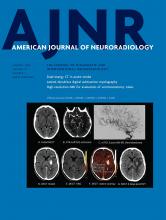Index by author
Chandrasekharan, K.
- FELLOWS' JOURNAL CLUBAdult BrainOpen AccessVessel Wall Thickening and Enhancement in High-Resolution Intracranial Vessel Wall Imaging: A Predictor of Future Ischemic Events in Moyamoya DiseaseA. Kathuveetil, P.N. Sylaja, S. Senthilvelan, K. Chandrasekharan, M. Banerjee and B. Jayanand SudhirAmerican Journal of Neuroradiology January 2020, 41 (1) 100-105; DOI: https://doi.org/10.3174/ajnr.A6360
Twenty-nine patients with Moyamoya disease were enrolled in this study. The median age at symptom onset was 12 years. A total of 166 steno-occlusive lesions were detected by high-resolution intracranial vessel wall imaging. Eleven lesions with concentric wall thickening (6.6%) were noted in 9 patients. Ten concentric contrast-enhancing lesions were observed in 8 patients, of which 4 lesions in 3 patients showed grade II enhancement. The presence of contrast enhancement and wall thickening showed a statistically significant association with ischemic events within 3 months before and after the vessel wall imaging. The presence of wall thickening and enhancement may predict future ischemic events in patients with MMD.
Chang, Y.-M.
- Adult BrainYou have accessUnilateral Nonvisualization of a Transverse Dural Sinus on Phase-Contrast MRV: Frequency and Differentiation from Sinus Thrombosis on Noncontrast MRIY.-M. Chang, A.L. Kuhn, N. Porbandarwala, R. Rojas, V. Ivanovic and R.A. BhadeliaAmerican Journal of Neuroradiology January 2020, 41 (1) 115-121; DOI: https://doi.org/10.3174/ajnr.A6337
Chen, X.
- FELLOWS' JOURNAL CLUBAdult BrainOpen AccessDeep Transfer Learning and Radiomics Feature Prediction of Survival of Patients with High-Grade GliomasW. Han, L. Qin, C. Bay, X. Chen, K.-H. Yu, N. Miskin, A. Li, X. Xu and G. YoungAmerican Journal of Neuroradiology January 2020, 41 (1) 40-48; DOI: https://doi.org/10.3174/ajnr.A6365
Fifty patients with high-grade gliomas from the authors’ hospital and 128 patients with high-grade gliomas from The Cancer Genome Atlas were included in this study. For each patient, the authors calculated 348 hand-crafted radiomics features and 8192 deep features generated by a pretrained convolutional neural network. They then applied feature selection and Elastic Net-Cox modeling to differentiate patients into long- and short-term survivors. In the 50 patients with high-grade gliomas from their institution, the combined feature analysis framework classified the patients into long- and short-term survivor groups with a log-rank test P value <.001. In the 128 patients from The Cancer Genome Atlas, the framework classified patients into long- and short-term survivors with a log-rank test P value of .014. In conclusion, the authors report successful production and initial validation of a deep transfer learning model combining radiomics and deep features to predict overall survival of patients with glioblastoma from postcontrast T1-weighed brain MR imaging.
Cho, S.J.
- Head and Neck ImagingYou have accessCT and MRI Findings of Glomangiopericytoma in the Head and Neck: Case Series Study and Systematic ReviewC.H. Suh, J.H. Lee, M.K. Lee, S.J. Cho, S.R. Chung, Y.J. Choi and J.H. BaekAmerican Journal of Neuroradiology January 2020, 41 (1) 155-159; DOI: https://doi.org/10.3174/ajnr.A6336
Choi, S.H.
- Adult BrainOpen AccessDynamic Contrast-Enhanced MR Imaging of Nonenhancing T2 High-Signal-Intensity Lesions in Baseline and Posttreatment Glioblastoma: Temporal Change and Prognostic ValueI. Hwang, S.H. Choi, C.-K. Park, T.M. Kim, S.-H. Park, J.K. Won, I.H. Kim, S.-T. Lee, R.-E. Yoo, K.M. Kang, T.J. Yun, J.-H. Kim and C.-H. SohnAmerican Journal of Neuroradiology January 2020, 41 (1) 49-56; DOI: https://doi.org/10.3174/ajnr.A6323
Choi, Y.J.
- Head and Neck ImagingYou have accessCT and MRI Findings of Glomangiopericytoma in the Head and Neck: Case Series Study and Systematic ReviewC.H. Suh, J.H. Lee, M.K. Lee, S.J. Cho, S.R. Chung, Y.J. Choi and J.H. BaekAmerican Journal of Neuroradiology January 2020, 41 (1) 155-159; DOI: https://doi.org/10.3174/ajnr.A6336
Chung, S.R.
- Head and Neck ImagingYou have accessCT and MRI Findings of Glomangiopericytoma in the Head and Neck: Case Series Study and Systematic ReviewC.H. Suh, J.H. Lee, M.K. Lee, S.J. Cho, S.R. Chung, Y.J. Choi and J.H. BaekAmerican Journal of Neuroradiology January 2020, 41 (1) 155-159; DOI: https://doi.org/10.3174/ajnr.A6336
Cinar, C.
- NeurointerventionYou have accessReduced Activity of von Willebrand Factor after Flow-Diverting Stent Implantation for Intracranial Aneurysms: A Link to Acquired von Willebrand Disease?I. Oran, C. Cinar, H. Bozkaya, M. Parildar and S. DumanAmerican Journal of Neuroradiology January 2020, 41 (1) 140-146; DOI: https://doi.org/10.3174/ajnr.A6343
Correa, D.G.
- Pediatric NeuroimagingYou have accessBrain MR Imaging of Patients with Perinatal Chikungunya Virus InfectionD.G. Corrêa, T. A. L. Freddi, H. Werner, F.P.P.L. Lopes, M.E.L. Moreira, F.C.P. de Almeida Di Maio Ferreira, J.M. de Andrade Lopes, F.C. Rueda-Lopes and L.C.H. da CruzAmerican Journal of Neuroradiology January 2020, 41 (1) 174-177; DOI: https://doi.org/10.3174/ajnr.A6339
Costalat, V.
- FELLOWS' JOURNAL CLUBNeurointerventionYou have accessFlow-Diversion Treatment for Unruptured Nonsaccular Intracranial Aneurysms of the Posterior and Distal Anterior Circulation: A Meta-AnalysisF. Cagnazzo, P.-H. Lefevre, I. Derraz, C. Dargazanli, G. Gascou, D.T. di Carlo, P. Perrini, R. Ahmed, J.F. Hak, C. Riquelme, A. Bonafe and V. CostalatAmerican Journal of Neuroradiology January 2020, 41 (1) 134-139; DOI: https://doi.org/10.3174/ajnr.A6352
The authors’ aim was to analyze the outcomes after flow diversion among nonsaccular unruptured lesions. Fifteen studies (213 aneurysms) were included in the analysis. The long-term adequate occlusion rate was 85.3%. Treatment-related complications were 17.4%. Overall, 15% were ischemic events. They conclude that unruptured nonsaccular aneurysms located in the posterior and distal anterior circulations can be effectively treated with a flow-diversion strategy. Nevertheless, treatment-related complications are not negligible, with about 15% ischemic events and 8% morbidity. Larger size (>10 mm) significantly increased the risk of procedure-related adverse events among nonsaccular lesions.








